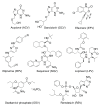Cyclodextrins in Antiviral Therapeutics and Vaccines
- PMID: 33808834
- PMCID: PMC8003769
- DOI: 10.3390/pharmaceutics13030409
Cyclodextrins in Antiviral Therapeutics and Vaccines
Erratum in
-
Correction: Braga et al. Cyclodextrins in Antiviral Therapeutics and Vaccines. Pharmaceutics 2021, 13, 409.Pharmaceutics. 2022 Feb 24;14(3):499. doi: 10.3390/pharmaceutics14030499. Pharmaceutics. 2022. PMID: 35336060 Free PMC article.
Abstract
The present review describes the various roles of cyclodextrins (CDs) in vaccines against viruses and in antiviral therapeutics. The first section describes the most commonly studied application of cyclodextrins-solubilisation and stabilisation of antiviral drugs; some examples also refer to their beneficial taste-masking activity. The second part of the review describes the role of cyclodextrins in antiviral vaccine development and stabilisation, where they are employed as adjuvants and cryopreserving agents. In addition, cyclodextrin-based polymers as delivery systems for mRNA are currently under development. Lastly, the use of cyclodextrins as pharmaceutical active ingredients for the treatment of viral infections is explored. This new field of application is still taking its first steps. Nevertheless, promising results from the use of cyclodextrins as agents to treat other pathologies are encouraging. We present potential applications of the results reported in the literature and highlight the products that are already available on the market.
Keywords: antiviral drugs; cyclodextrins; inclusion complexes; vaccines.
Conflict of interest statement
The authors declare no conflict of interest.
Figures








References
-
- Roth G.A., Abate D., Abate K.H., Abay S.M., Abbafati C., Abbasi N., Abbastabar H., Abd-Allah F., Abdela J., Abdelalim A., et al. Global, regional, and national age-sex-specific mortality for 282 causes of death in 195 countries and territories, 1980–2017: A systematic analysis for the Global Burden of Disease Study 2017. Lancet. 2018;392:1736–1788. doi: 10.1016/S0140-6736(18)32203-7. - DOI - PMC - PubMed
Publication types
Grants and funding
LinkOut - more resources
Full Text Sources
Other Literature Sources

